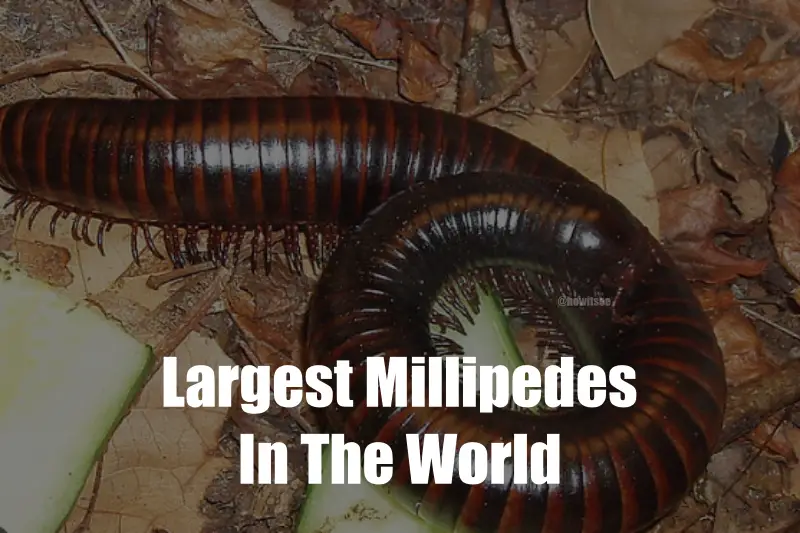Millipedes are among the largest arthropods, with almost 12,000 extant species crawling about on the Earth’s surface. They are mostly ground-dwelling arthropods and are detritus feeders.
The word millipede means “a thousand feet,” referring to its large number of jointed legs. With so many species wandering the Earth and each with its characteristic size and colors, a common question arises, which are the largest millipedes in the world?
Let’s discuss.
Top 7 Largest Millipedes In The World
7) American Giant millipede
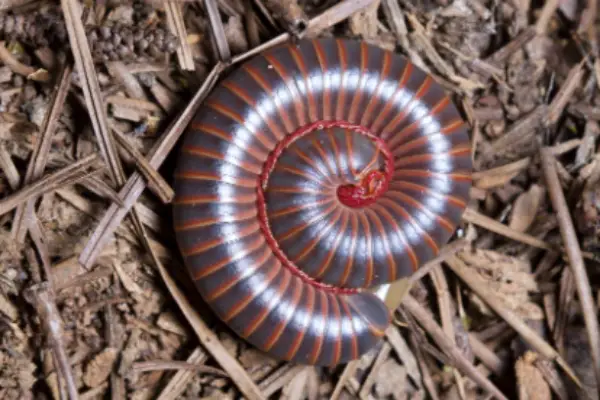
| Genus | Narceus |
| Scientific name | Narceus Americanus |
| Size | 10-13 cm |
| Location | North American Wetlands |
Starting with, we have an endemic species, the American Giant Millipede, which bears an average body length of 4-5 in, with a cylindrical body. Grey is the base body color, with alternating brown stripes.
These millipedes are found in areas rich in moisture, like the underside of decaying dead logs, which serve to be a primary food source.
Moist soil is an essential factor for its living and survival, as they need to keep their body hydrated and has water-permeable cuticles for this very reason.
6) Smokey Oak Millipede

| Genus | Marcus |
| Scientific name | Narceus gordanus |
| Size | 6-15.5 cm |
| Location | native to the Southeastern United States |
Commonly known as the Smokey Oak millipede, the Narceus gordanus is generally 6 – 12 cm (2.5-4.5 in), on average in length and bears a body weight of nearly 0.5 in.
This species of millipede can be easily identified by its coloration, which has a light greenish hue followed by a darker tan, which acts as a camouflage in the environment it lives in.
The long body bears nearly 50-60 segments. Narceus gordanus is believed to be a nocturnal species, and its diet ranges from leaf litter and soil detritus to leaves and decaying wood matter.
5) Paeromopus angusticeps
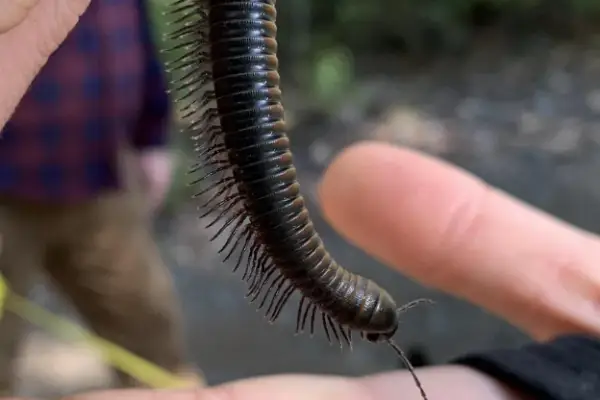
| Genus | Paeromopus |
| Scientific name | Paeromopus angusticeps |
| Size | 10-15 cm |
| Location | Northern California |
One of the largest millipedes on the planet, the Paeromopus angusticeps covers quite a large geographic area. The body length varies anywhere between 10 – 15 cm (4-6 in) and is divided into as many as 80 segments.
This millipede species can be distinguished from other species by their coloration, which has black or black with a bluish tint as the base color and alternating brown bands.
Their diet primarily consists of soil detritus, leaf litter, and other vegetation occurring on the soil surface.
4) Paeromopus paniculus

| Genus | Paeromopus |
| Scientific name | Paeromopus paniculus |
| Size | up to 16.6 cm |
| Location | Sierra Nevada Mountain range in California (endemic species) |
On the 5th position on our list of largest millipedes in the world, we have the longest millipede species occurring in North America, the Paeromopus paniculus. With lengths occurring as long as 16.6 cm (6.5 in), it can be counted among the longest millipede species.
This species comes in its general dark brownish coloration and have lateral grooves passing across its body, a characteristic feature of its family.
Despite being the longest millipede in North America, we have placed it in the 5th position due to its narrow body, which is only 0.2 in wide.
3) Desert millipede
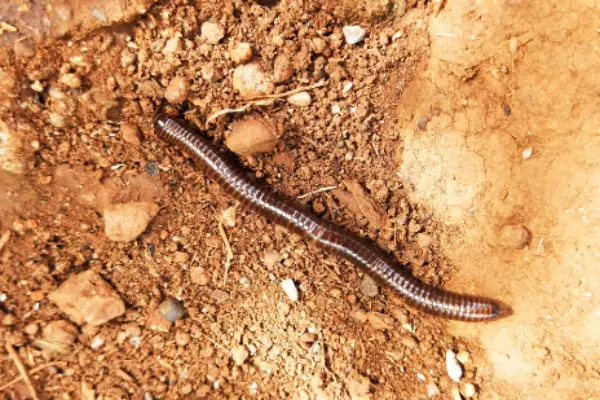
| Genus | Orthoporus |
| Scientific name | Orthoporus ornatus |
| Size | 12-22 cm |
| Location | American states of Texas and Arizona and even in certain Mexican states |
Desert centipedes have gained wide popularity thanks to their skyrocketing demand in the pet trade. With an average size of nearly 5 inches (some specimens have shown lengths as long as 9 in), this is undoubtedly one of the largest millipedes species on the planet.
One can easily identify them by their dark brown coloration and black stripes (sight differences might arise based on their location). Its diet mainly consists of microorganisms present in humid soil and dead decaying matter.
Since moist soil is a must for its feeding, hence desert centipedes prefer damp areas, quite contrary to their name.
2) Giant chocolate millipede
| Genus | Ophistrephus |
| Scientific name | Ophistrephus guineensis |
| Size | 20-25 cm |
| Location | Arid Savannah areas of Ghana and Nigeria |
The second-largest millipede, the Giant Chocolate millipede, gets its name from its distinctive brown coloration. Adult millipedes generally occur in the range of 20-25 cm (7- 9 in).
They are soil-dwelling species and spend the majority of their time in the soil. Their body segments have dual shades, a lighter and a darker tan brown.
Like other millipede species, they forage on soil detritus and decaying dead leaves, and other organic matter. Over the past few years, these giant millipedes have become immensely popular as indoor ex*tic pets.
1) Giant African Millipede

| Genus | Archispirostreptus |
| Scientific name | Archispirostreptus gigas |
| Size | up to 30 cm |
| Location | Subtropical rainforests of Western Africa |
With an enormous body length of 12 in, or sometimes even higher, the Giant African Millipede deserves the first position on our list of largest millipedes.
The body coloration is on the darker side, with it being dark brown or black, while the legs have a relatively lighter shade. The body is round and bears approximately 40-45 segments.
The Giant African Millipedes are mostly found crawling on the rainforest’s floors, which are rich in biodiversity. The region provides ideal conditions for its survival.
Feeding habits mainly consist of detritus, like several other species, which mainly includes dead decaying organic matter, leaves, etc.
Special Mention
Almost every one of the millipedes that we have mentioned in today’s list has a body length in centimeters. Did you know there existed a time when prehistoric millipedes with an alarming length of nearly 9 feet crawled around on this very Earth?
Well, a recent fossil discovery of the extinct Arthopleura genus says it all. This long-lost genus roamed the Earth around 325 million years ago and made us wonder what would have happened if they existed to date.
The pet industry has added a new chapter, Millipedes, to its ex*tic pet trade. Millipedes make excellent indoor pets and have become highly popular terrarium organisms.
Due to their inexpensive diet and low maintenance, more and more people are adding up each year as millipede owners. Millipedes play a huge role in nature’s nutrient cycle and decomposing the dead decaying matter.
The world is home to a diverse array of millipedes, some of which reach astonishing sizes. In this article, we have explored the top seven largest millipedes, marveling at their impressive dimensions and adaptations.
From the massive African Giant Black Millipede to the enormous Ophistrephus guineensis, these creatures showcase the incredible variety of sizes within the millipede family.
These giant millipedes have evolved unique defenses, such as toxic secretions or formidable exoskeletons, to protect themselves from predators. Their size also allows them to occupy specialized ecological niches and fulfill important roles in their respective ecosystems.
Studying and appreciating these largest millipedes not only expands our understanding of the natural world but also highlights the remarkable adaptations that have enabled these creatures to thrive.
As we continue to explore and uncover the wonders of the natural world, it is clear that these magnificent millipedes hold a special place among the diverse and captivating creatures that inhabit our planet.
Here we conclude our article on the Largest Millipedes in the world. Hope you have liked our article. We will be returning soon, so stay tuned until then.
Also Read:
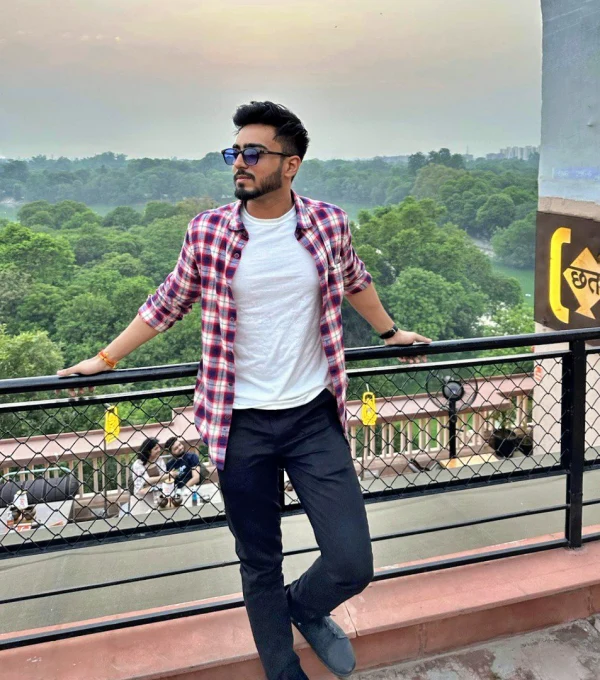
Meet Abhidept (nickname Monty), the visionary founder of How It See, being an engineering student, he’s fueled by an insatiable curiosity about the world around him. He is captivated by an eclectic correlation between animal groups, science, and nature, and this fascination drives his quest for understanding.
After completing his degree, he’s set on a mission to delve deep into the realm of nature, accumulating knowledge to share with you through his writing. In the meantime, he loves to watch anime and read anime.
